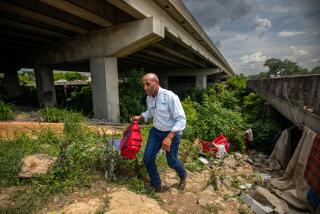Mississippi Region Increasingly Dependent on Handouts : In Sharkey County, Uncle Sam’s the One Footing Bills
- Share via
ROLLING FORK, Miss. — Along this rural stretch of U.S. Highway 61, which for decades has siphoned off thousands of Sharkey County people north toward jobs in Memphis, St. Louis and Chicago, it seems like everyone left leans on Uncle Sam.
A branch of the U.S. Department of Agriculture serves as the county’s dominant bank. The county welfare director says she handles its largest payroll.
Nearly half the county’s 7,900 residents receive food stamps. Federal farm programs pumped at least $14.3 million into some of the nation’s best cotton and soybean land in 1986. Last year’s severe drought and depressed cotton prices only deepened a half-century pattern of reliance on federal handouts.
‘Keeping Them Going’
“Right now, these programs are all that’s keeping them going,” said Lee Martin, vice president of the Bank of Anguilla in Rolling Fork.
Two of three industrial plants moved away: one out of Anguilla shortly after unionization, a lumber yard out of Cary after Illinois Central Gulf Railroad Corp. ripped out its tracks.
County unemployment stood at 26.1% in April, and Martin said it is an uphill battle to attract replacement jobs.
“Any industry that we talk to, they find out what our educational level is and scratch us off the list,” Martin said. “We’ve got to find some type of industry we can bring in here that can get these people working now. We can’t wait until the next generation.”
Sharkey County’s situation is not unique in Mississippi, where per capita income, the nation’s lowest, has dipped to 66 cents for every dollar the average American earns and transfer payments are the single largest source of income. The handouts dominate the Delta’s economy and 51 of the state’s 82 counties.
$4.8 Billion in Payments
Transfer payments, or government payments to individual citizens, range from retirement and disability checks to workers’ compensation, emergency assistance and welfare. Of the $24 billion in income Mississippi received in the 1984 fiscal year, transfer payments totaled $4.8 billion. All manufacturing in the state produced $4.3 billion, services $2.82 billion.
“You’ve got to understand that this part of the country is basically subsidized by the U.S. government,” said Don Schilling, who owns Sunflower supermarkets in Rolling Fork and Hollendale.
Schilling said 40% of his sales come from food stamps and Social Security supplemental income, with most business coming the first two weeks of the month when checks come out.
“If food stamps and the supplement checks come out on the same day, we’re swamped,” he said.
County Welfare Director Lucy Boykin says food stamps go to 3,741 of the county’s 7,900 residents, about 46%, and 438 people receive federal Aid to Families With Dependent Children. The department distributed about $2.27 million under the two programs in the 1986 fiscal year, she said.
Ambition Hindered
The 22-year department veteran is seeing her third generation of welfare recipients in some families. She said the lack of opportunity hinders ambition, prolonging dependence on Uncle Sam and undermining the need for education and job training.
The Cary Christian Center, a missionary outpost that operates a medical and dental clinic and thrift store, tries to buck the trend with child-care and job training classes, but interim director Jack Matheis says the task is daunting.
“Lack of education creates lack of skills. Without skills, there’s no way you can compete for a job,” Matheis said. “What jobs there are go at minimum wage.”
Social workers report low self-esteem and little self-reliance among poor people in a county that over the years has lost many of its best to the promise of jobs to the north. Hundreds still live in shanties without running water.
County residents point to its poorest members as the focus of federal assistance, but the upper crust actually takes home the biggest government checks, said Johnny Guntharp, county director of federal Agricultural Stabilization and Conservation Service.
$1.1 Million in Disaster Aid
Guntharp said the county’s 190 farmers received $13.2 million in deficiency crop payments last year and $1.1 million in federal disaster relief for the parched soybean crop.
The deficiency crop payments make up the difference between the market price and the government targeted price for certain crops.
For county cotton farmers, who received about $7 million of that $13.2 million, that meant that the government gave them 26 cents for each pound of cotton, almost half the 55 cents-per-pound market price, to meet the federally set target price of 81 cents.
George Cortwright, who owns 4,000 acres among four plantations on either side of Rolling Fork, has witnessed the growth of federal farm programs since President Franklin D. Roosevelt’s plan to pull up every third row of crops in the 1930s.
“In this country,” said Cortwright, 68, a former president of the National Cotton Council, “70% of lands growing crops couldn’t cash flow without the government payments.”
15% of Farmers Go Broke
Officials say about 15% of the county’s farmers went broke in the last few years, and Cortwright estimates that another 15% will go under in the next five years. He believes 25% to 30% of marginal farmland here will be fallow within three years.
Social workers and officials don’t know where the newly displaced farmers will go, or those who help work and harvest the land.
“Our people are becoming increasingly dependent on government handouts all the time,” said Matheis. “More people are on government pensions. More people are taking, or are being forced to take, early retirement. They find themselves outside of the work force and cannot get back in.
“These people are not producing in our society. Sometime soon, we are going to have to find something to do with them.”
More to Read
Sign up for Essential California
The most important California stories and recommendations in your inbox every morning.
You may occasionally receive promotional content from the Los Angeles Times.













